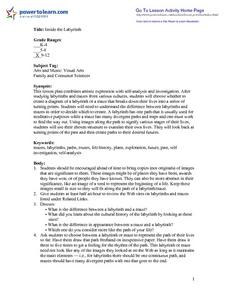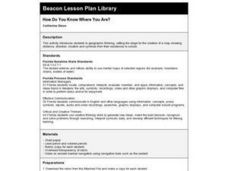Curated OER
Calculator Numbers
Third graders practice working out a hidden number on a calculator via number sequence in the advanced additive stage six. They assess number sequence to unveil a mystery number that has been entered onto a calculator and then switch...
The New York Times
Big Brother vs. Little Brother: Updating Orwell's 1984
Government surveillance is an enduring conflict that has become increasingly complex with our nation's use of technology. Add to the understanding of Orwell’s 1984 by using the resources here that display the contemporary actions of Big...
Curated OER
Paris Peace Conference: Writing a Treaty to End World War I
How did World War I end? Tenth graders role play as experts from countries that were involved in World War I. They write a treaty to end the war and compare it to the Treaty of Versailles.
Curated OER
The Water Cycle
First graders investigate the different stages of the water cycle. They conduct Internet research and complete a water cycle WebQuest. Students identify what happens at each stage of the water cycle, and write about each stage in their...
Curated OER
Life of An Island
Students identify the steps in the life cycle of an island. They label islands in the correct stage of their life cycle and illustrate the process themselves. They also review the concept of plate tectonics.
Curated OER
Butterfly Lifecycle
First graders examine diagrams of butterflies printed from the stated website and follow directions to make a model of the butterly life cycle. They then participate in a WebQuest to observe the life cycle stages of a butterfly.
Curated OER
Monarch Egg
Students investigate the stages of the Monarch butterfly and its life cycle. In this butterfly life cycle lesson, students discuss when, where, and how the Monarch butterflies lay their eggs. After discussion, students participate in...
Curated OER
Data Collection and Record Keeping. Measuring Larval Growth and Development
Students keep data records of the growth of Monarch larvae. The observations are made with the change of each stage of development. The observations are to stimulate the answering of questions about biological development.
Curated OER
Brine Shrimp Life Cycle
Second graders investigate the life cycle of the brine shrimp. They use a variety of resources to find the details of each step. Students compare the life cycles of different organisms. They create diagrams of the different stages while...
Curated OER
Birth of a Butterfly
Learners demonstrate an understanding of insects and science as a whole and construct the life cycle of a butterfly using pasta. They first fold a piece of paper into four equal parts. In the upper left corner will be stage one (egg)....
Curated OER
The Birth of an American Hero: Henry Wadsworth Longfellow???s ???Paul Revere???s Ride???
Students examine the heroic archetype and apply it to the history of Paul Revere's Ride and to Longfellow's poem, "Paul Revere's Ride." They identify heroic qualities, discuss archetypes, read and discuss Joseph Campbell's "Stages of the...
Curated OER
Microscope Basics
Students examine a microscope and learn its parts. In this microscope lesson students study the different parts of the microscope and see the differences in the adjustments then make their own wet slide.
Curated OER
What Are You Doing?
Students use current time indicators while learning to talk about on-going action. In these vocabulary lessons, students works with power point presentations, games, flashcards, worksheets and video slides.
Curated OER
Presto Change-o: Caterpillars to Butterflies
Students use the Internet to explore the four stages of a butterfly's life cycle. They make a model of a butterfly using macaroni, sticks and leaves.
Curated OER
Debate On Ratification
Students simulate a delegate that was responsible for the Constitution. They research their arguments, and stage a debate in front of the state's legislature (the class). The class then vote whether or not to ratify the new Constitution.
Curated OER
Forming Committees
Students analyze types of events, choose one to plan for appreciation event, determine committees necessary for planning and staging event, list duties of each committee, and place each committee function on timeline relative to date of...
Curated OER
GREETINGS AND LEAVE TAKINGS
Students respond with memorized answers to questions that use familiar language. They ask basic memorized questions and imitate sounds and words with age- and stage- appropriate pronunciation. They Use the appropriate interpersonal...
Curated OER
I Can Sing a Rainbow....
In this Blakesley Hall Museum gardens worksheet, students view eleven pictures of garden flowers and learn the words to a garden song.
Curated OER
We the People... What Conflicting Opinions Did the Framers Have about the Completed Constitution?
Students study some of the disagreements about the Constitution which set the stage for the debates over its ratification. These are significant because many have to do with issues that are still discussed and debated today.
Curated OER
Women in Jazz
Students watch a video: "VH1 Millennium Jazz Festival From The White House" to become familiar with prominent women in jazz. They discuss the vocally oriented nature of jazz and the contributions made by women on and off stage.
Curated OER
Inside the Labryinth
Students create a diagram of a labyrinth or a maze using information from their lives. As a class, students discuss the significant features and differences between a labryinth and a maze. They create the the twists and turns of the...
Curated OER
Science: The Water Cycle
Students examine the various stages of the water cycle. In groups, they complete a hands-on activity by creating model water cycle. Students design posters representing each of the seven stages of the water cycle.
Curated OER
How Do You Know Where You Are?
Seventh graders are introduced to geographic thinking, setting the stage for the creation of a map showing distance, direction, location and symbols from their residences to school.
Curated OER
Barnacles: Harder than Cement
Fourth graders watch the movements of the complex animal hidden inside the tiny barnacle shells. This lesson allows students to study the behavior, adaptation, and larval stage of the barnacle.

























